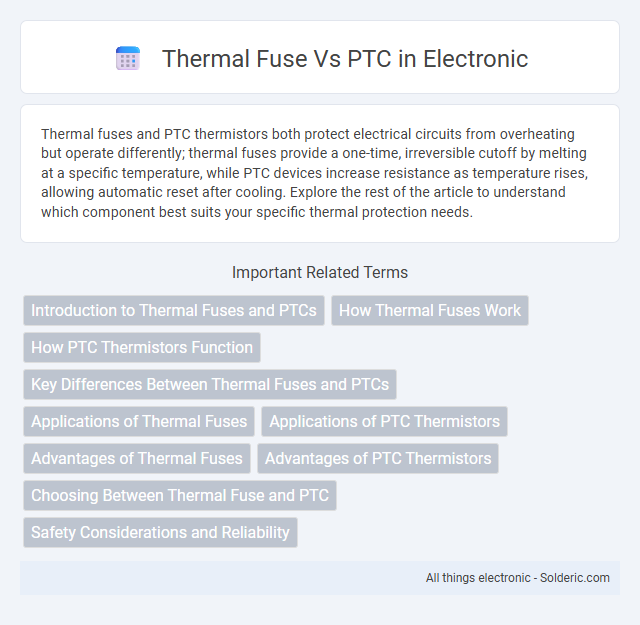Thermal fuses and PTC thermistors both protect electrical circuits from overheating but operate differently; thermal fuses provide a one-time, irreversible cutoff by melting at a specific temperature, while PTC devices increase resistance as temperature rises, allowing automatic reset after cooling. Explore the rest of the article to understand which component best suits your specific thermal protection needs.
Comparison Table
| Feature | Thermal Fuse | PTC (Positive Temperature Coefficient) |
|---|---|---|
| Function | Permanent circuit interrupt at a specific temperature | Temperature-dependent resistor limiting current when heated |
| Operation | One-time use; blows and breaks circuit | Self-regulating; current reduces as temperature rises |
| Reset Capability | Non-resettable | Resettable when cooled down |
| Typical Applications | Overheat protection in appliances and electronics | Overcurrent protection, motor starters, and temperature sensors |
| Response Time | Fast response to overheating | Slower response compared to thermal fuses |
| Durability | Single-use; must be replaced after activation | Multiple cycles; long-lasting performance |
| Cost | Low cost | Moderate cost |
Introduction to Thermal Fuses and PTCs
Thermal fuses and PTC (Positive Temperature Coefficient) thermistors are critical components in electrical circuit protection and temperature regulation. Thermal fuses provide a one-time cutoff by physically breaking the circuit when exceeding a specified temperature threshold, ensuring safety by preventing overheating. PTC thermistors, in contrast, allow current to flow under normal temperatures but increase resistance sharply at higher temperatures, reducing current flow and protecting devices through self-regulating heat control.
How Thermal Fuses Work
Thermal fuses provide reliable overcurrent protection by breaking the circuit when a specific temperature threshold is exceeded, preventing potential overheating or fire hazards. Unlike PTC thermistors that limit current by increasing resistance, thermal fuses contain a heat-sensitive alloy that melts and irreversibly interrupts electrical flow once the critical temperature is reached. Your device's safety is ensured through this precise mechanism, making thermal fuses essential components in many electrical appliances.
How PTC Thermistors Function
PTC thermistors function by increasing resistance sharply as temperature rises, acting as self-regulating heaters that limit current flow when reaching a specific threshold. Unlike thermal fuses, which permanently break the circuit when overheated, PTC thermistors automatically reset once cooled, allowing continuous device protection without replacement. Their reversible and reusable nature makes PTC thermistors ideal for overcurrent and overtemperature protection in electronic circuits and appliances.
Key Differences Between Thermal Fuses and PTCs
Thermal fuses and Positive Temperature Coefficient (PTC) devices both serve as protective components in electrical circuits but function differently based on temperature. Thermal fuses provide a one-time irreversible cut-off when the temperature exceeds a specific threshold, safeguarding against overheating and potential fire hazards. PTC devices, in contrast, increase their resistance with rising temperature, allowing them to reset automatically once cooled, making them ideal for overcurrent protection in applications requiring repeated use.
Applications of Thermal Fuses
Thermal fuses are commonly used in household appliances such as coffee makers, hair dryers, and refrigerators to provide critical overheat protection by permanently cutting off the electrical circuit when temperatures exceed safe limits. These devices are ideal for applications requiring a one-time fail-safe response to prevent fire hazards or equipment damage. Your safety in everyday electronics relies heavily on the reliable operation of thermal fuses in these essential appliances.
Applications of PTC Thermistors
PTC thermistors are widely used in overcurrent protection, temperature sensing, and self-regulating heating elements due to their positive temperature coefficient which causes resistance to increase with temperature. Common applications include circuit protection in power supplies, motor windings, and rechargeable batteries to prevent overheating and damage. Their rapid response and resettable nature make PTC thermistors essential components in automotive electronics, home appliances, and HVAC systems.
Advantages of Thermal Fuses
Thermal fuses offer precise temperature protection by permanently breaking the circuit when a critical temperature is exceeded, ensuring reliable safety measures in electrical devices. They are cost-effective, compact, and require no reset, making them ideal for single-use safety applications in appliances and electronics. Their simplicity and fast response time minimize hazards from overheating and prevent potential fire risks.
Advantages of PTC Thermistors
PTC thermistors provide self-regulating overcurrent protection by increasing resistance as temperature rises, preventing damage without the need for replacement after tripping. Their rapid response time and resettable nature reduce downtime and maintenance costs compared to one-time-use thermal fuses. PTC thermistors also offer compact size and high reliability in applications such as power supplies, motors, and battery packs.
Choosing Between Thermal Fuse and PTC
Choosing between a thermal fuse and a PTC resettable fuse depends on the application's temperature control and reset requirements. Thermal fuses provide a one-time, precise cutoff at a specific temperature, making them ideal for permanent safety protection in appliances and electronics. PTC fuses allow automatic reset after overheating events, balancing circuit protection with continued device operation without replacement.
Safety Considerations and Reliability
Thermal fuses provide a reliable one-time safety cutoff by permanently breaking the circuit when temperatures exceed a critical limit, ensuring protection against overheating and fire hazards. PTC thermistors offer resettable overcurrent protection by increasing resistance as temperature rises, enabling repeated use but potentially slower response to extreme temperature spikes. Both components prioritize safety; thermal fuses guarantee irreversible interruption for critical failures, while PTC devices maintain circuit continuity with self-resetting properties for less severe conditions.
Thermal fuse vs PTC Infographic

 solderic.com
solderic.com